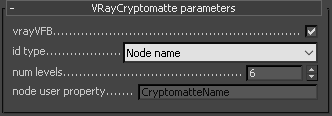Cryptomatte | VRayCryptomatte
This page gives information on the Cryptomatte Render Element.
Page Contents
Overview
Cryptomatte is a method developed by Psyop for efficiently encoding accurate mattes. It uses typically three to five render elements (which are automatically generated) with multichannel OpenEXR files, which removes the hassle of creating dozens, or hundreds, of Multimattes. Using the Cryptomatte plugin for NUKE or Fusion, mattes can be extracted through directly picking objects or entering object names.
Compared to the Multimatte Render Element, Cryptomatte offers the following:
-
Does not require a setup with object IDs, etc.
-
Only requires a fixed number of additional render elements, typically four.
-
Cannot be propagated through reflections or refractions.
Currently, the Cryptomatte Render Element requires the Bucket Image Sampler and outputs set to multichannel OpenEXR files saved from the V-Ray raw image file output in the Render Setup > V-Ray > Frame buffer settings. Directly saving from the V-Ray Frame Buffer is not supported yet.

UI Path: ||Render Setup window|| > Render Elements tab > Add button > VRayCryptomatte
Parameters
This render element is enabled through the Render Elements tab of the Render Setup window in 3ds Max and displays its parameters in a rollout at the bottom of the window:

vrayVFB – When enabled, the render element appears in the V-Ray frame buffer.
id type – Specifies how the ID mattes are determined.
Node name – Creates mattes by node names.
Node name with hierarchy – Creates mattes by node names and takes the node hierarchy into account for linked or grouped objects.
Node material name – Creates mattes based on the materials in the scene.
Node user property – Creates mattes from a property specified in the node user property field.
Layer name – Creates mattes based on the layer names in the scene.
num levels – Specifies the number of levels for the render element, which determines the number of objects that can be distinguished per pixel. If multiple objects intersect at a single pixel, higher-order elements will contain non-zero results. The default value of 6 is normally enough for most cases.
node user property – Specifies a user-defined property for creating ID mattes when id type is set to Node user property.